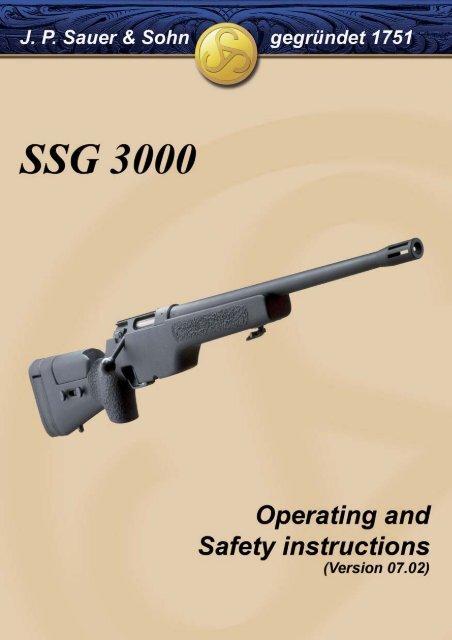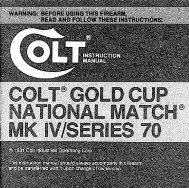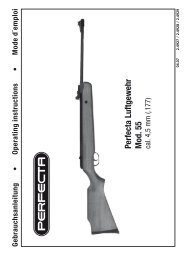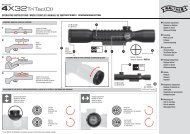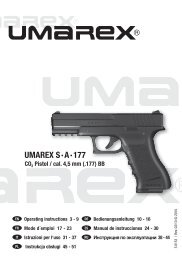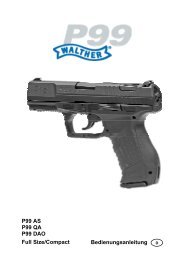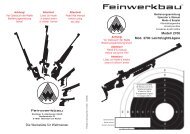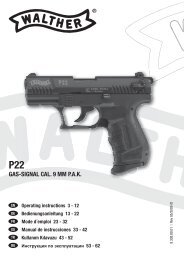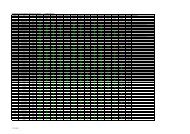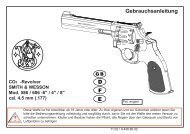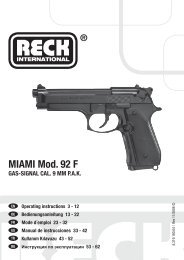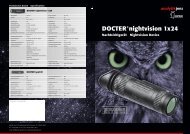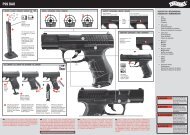Untitled - Frankonia
Untitled - Frankonia
Untitled - Frankonia
Create successful ePaper yourself
Turn your PDF publications into a flip-book with our unique Google optimized e-Paper software.
Table of contents<br />
1 General instructions 2<br />
2 Safety regulations 3<br />
2.1 Safe handling of the rifle 3<br />
2.2 Risks for the user and how to<br />
avoid them 3<br />
2.3 Risks for other people and how to<br />
avoid them 3<br />
2.4 Ensure proper use 4<br />
2.5 Personal protective equipment 4<br />
2.6 Graphical representation of<br />
safety indications 4<br />
3 Product description 5<br />
3.1 Main parts 5<br />
3.2 Technical specifications 6<br />
3.3 Main features 7<br />
3.4 Scope of supply 7<br />
3.5 Accessories 8<br />
3.6 Installation of optics and<br />
accessories 8<br />
3.7 Extras 8<br />
3.7.1 Installation of optional accessories<br />
on the mounting rail 8<br />
3.8 Spare parts 8<br />
4 Transporting, storing and<br />
shipping the rifle 9<br />
4.1 Transporting the rifle 9<br />
4.2 Storing the rifle 9<br />
4.3 Shipping the rifle 9<br />
5 Handling the rifle 10<br />
5.1 Initial preparation 10<br />
5.2 Ammunition 10<br />
5.3 Loading the rifle (ready to fire) 10<br />
5.4 Discharging a shot 11<br />
5.5 Reloading during shooting 12<br />
5.6 Unloading the rifle 12<br />
5.7 Bolt 13<br />
5.7.1 Cocking the bolt 13<br />
5.7.2 Removing the bolt 13<br />
5.7.3 Inserting the bolt 14<br />
5.7.4 Uncock the firing pin 14<br />
5.8 Magazine 14<br />
5.8.1 Removing the magazine 14<br />
5.8.2 Inserting the magazine 15<br />
5.8.3 Loading the magazine 15<br />
5.9 Trigger 15<br />
5.9.1 Setting the take-up 15<br />
5.9.2 Setting the trigger position 16<br />
5.9.3 Setting the let-off point 16<br />
6 Safety lock 17<br />
6.1 Safety OFF 17<br />
6.2 Lock 17<br />
7 Stock 18<br />
7.1 Removing the cheekpiece 18<br />
7.2 Stock setting options 18<br />
7.2.1 Adjusting cheekpiece offset 18<br />
7.2.2 Adjusting cheekpiece for height 18<br />
7.2.3 Adjusting the buttplate length 19<br />
7.3 Installing the cheekpiece 19<br />
8 Dismantling 19<br />
8.1 Removing the stock 19<br />
8.2 Removing the carrying sling 19<br />
8.3 Removing the barrel 20<br />
9 Care 20<br />
9.1 General remarks 20<br />
9.2 Cleaning the barrel 20<br />
9.3 External metal surfaces 21<br />
10 Assembly 22<br />
10.1 Fitting the barrel 22<br />
10.2 Installing the stock 22<br />
10.3 Fitting the carrying sling 22<br />
11 Training system cal. 22 lr. 23<br />
11.1 Caliber conversion cal. 22 lr. 23<br />
12 Accessories 24<br />
12.1 Scopes 24<br />
12.1.1 Installing the scope 24<br />
12.1.2 Removing the scope 24<br />
12.2 Adjusting eye relief length 24<br />
12.3 Removing the mirage band 24<br />
12.4 Installing the mirage band 25<br />
13 Malfunctions 25<br />
13.1 Detecting a malfunction 25<br />
13.2 Cause and remedy of malfunctions 26<br />
1 GB<br />
07.02
General instructions<br />
1 General instructions<br />
Be sure to read through these instructions<br />
carefully before any manipulation on this<br />
SAUER rifle.<br />
Keep this instructions carefully with the<br />
SAUER rifle for later use.<br />
If the rifle changes hands these instructions<br />
must be given to the new owner.<br />
Understanding these instructions and the<br />
technically correct implementation of the<br />
information contained therein are imperative to<br />
correct preparation and safety during handling,<br />
maintenance and care of this SAUER rifle.<br />
Do not use the rifle until you have fully understood<br />
all safety instructions and its handling procedures.<br />
Should you require further information, do not<br />
hesitate to contact your dealer, importer or the<br />
manufacturer.<br />
Please observe the local and national legislation<br />
governing the ownership, carrying and use of<br />
firearms.<br />
The owner of the rifle must have a valid firearms<br />
licence in order to buy and own the rifle.<br />
Permission to shoot the rifle is given by way of a<br />
permit.<br />
Be aware that rifles, like all firearms, are<br />
dangerous. The rifle accompanying these<br />
Operating and Safety Instructions has been sold<br />
under the express understanding that the<br />
manufacturer and the importer of the rifle decline<br />
any responsibility for consequences of<br />
manipulations on the rifle or use of the rifle.<br />
This applies in particular to liability for bodily harm<br />
or damage to property resulting in part or in whole<br />
to:<br />
– use with criminal intent or negligent use,<br />
– improper or careless handling,<br />
– defective, incorrect, hand-loaded or reloaded<br />
ammunition,<br />
– inadequate care of the rifle (e.g. corrosion,<br />
damage),<br />
– disregard of malfunctions,<br />
– resale in contradiction of regional legislation<br />
and regulations,<br />
– other circumstances beyond our direct and<br />
immediate control.<br />
These limitation apply regardless of whether<br />
liability is asserted on the basis of contract,<br />
negligence or strict liability (including any failure to<br />
warn).<br />
The manufacturer and the importers are not liable<br />
for incidental or consequential damages such as<br />
loss of use of property, commercial loss or loss of<br />
earnings and profits.<br />
07.02 GB<br />
2
Safety regulations<br />
2 Safety regulations<br />
Be sure to read through these instructions<br />
carefully before each handling or use of this<br />
SAUER rifle and that you have understood<br />
them.<br />
2.1 Safe handling of the rifle<br />
• Never try to modify or convert the rifle yourself.<br />
Only use approved original accessories.<br />
• Always think of the rifle as being loaded and<br />
with the safety off until you have established<br />
the opposite through the unloading procedure.<br />
• Never shoot with a rifle which has been<br />
penetrated by water, sand, dirt or other foreign<br />
bodies.<br />
• Always keep the rifle and the ammunition<br />
separate from one another, and ensure that<br />
neither is obtained by unauthorized persons or<br />
children.<br />
• Always treat your rifle as if the safety<br />
mechanisms were not functioning. The best<br />
safety precaution is a correct, well-trained and<br />
safe handling of the rifle.<br />
• Never rely on safety mechanisms alone.<br />
Safety mechanisms are not a substitute for<br />
careful, correct and secure handling of the rifle.<br />
• Never store the rifle loaded, but remove the<br />
magazine and verify that there is no cartridge<br />
left in the chamber of the barrel by following<br />
the unloading procedure.<br />
• Never check the safety lock of the rifle by<br />
pulling the trigger.<br />
2.2 Risks for the user and how to avoid<br />
them<br />
• Never use the rifle under the influence of drugs<br />
or alcohol, while ill or suffering other such<br />
difficulties. These conditions can impair your<br />
powers of judgment and reflexes.<br />
• Never aim at yourself or other people.<br />
• Never place your hand in front of the muzzle,<br />
above the barrel chamber or behind the slide.<br />
• Always unload the rifle immediately after firing,<br />
before putting the rifle away, putting into a<br />
holster or handing it to another authorised<br />
person.<br />
• Never point the rifle at doors, panes of glass,<br />
walls, concrete, stone or flat surfaces<br />
(including water). A bullet can penetrate such<br />
surfaces or be ricocheted in an unsafe<br />
direction.<br />
• Take care not to breathe in the developing<br />
gunpowder smoke or get it into the eyes.<br />
Should this happen, stop shooting<br />
immediately.<br />
2.3 Risks for other people and how to avoid<br />
them<br />
• Never let a loaded rifle out of your hand.<br />
• Never leave the rifle unattended and protect<br />
the rifle against unauthorised access.<br />
• Never give the rifle to a person who has not<br />
thoroughly familiarised himself or herself with<br />
the safety instructions and handling of the rifle,<br />
by reading the corresponding instructions.<br />
3 GB<br />
07.02
Safety regulations<br />
• Always keep the muzzle of the rifle in a safe<br />
direction with all handling. A safe direction is<br />
towards an area where there are no people,<br />
other life forms or property that is not a<br />
recognised target.<br />
• Also make sure what lies behind your target.<br />
• Point out any dangers from noise, empty<br />
cartridges and gunpowder smoke to those<br />
present. Stop shooting immediately if such<br />
dangers occur.<br />
2.4 Ensure proper use<br />
• The owner of the rifle must ensure that it is<br />
only used for its intended purpose.<br />
• The incorrect, careless or improper use of the<br />
rifle causes risks for the life and limb of the<br />
user and for other people or living beings.<br />
2.5 Personal protective equipment<br />
• When shooting, always wear ear protection<br />
and protective glasses. Inform other people<br />
close to you about the need to wear ear<br />
protection and protective glasses.<br />
2.6 Graphical representation of safety<br />
indications<br />
In the individual sections of these<br />
instructions, the following safety indications<br />
alert you to risks:<br />
DANGER!<br />
Information on dangers, which if not<br />
scrupulously observed, will result in immediate<br />
severe bodily harm or death.<br />
WARNING!<br />
Information on dangers, which if not<br />
scrupulously observed, can lead to severe<br />
bodily harm or death.<br />
CAUTION!<br />
Information on dangers, which if not<br />
scrupulously observed, can lead to bodily harm,<br />
damage to property and damage to the rifle.<br />
CAUTION!<br />
Information on technical requirements, which if<br />
not scrupulously observed, can lead to damage<br />
to the rifle.<br />
• Each of these safety indications consists of:<br />
– a headline with a signal word, a signal<br />
pictorial and a corresponding colour code<br />
– a description of the danger type and source<br />
– a description of possible consequences if<br />
the safety indications message is ignored<br />
– a description of actions or regulations for<br />
danger prevention<br />
07.02 GB<br />
4
Product description<br />
3 Product description<br />
3.1 Main parts<br />
500<br />
100<br />
Fig. 1, SSG 3000 with McMillan plastic stock<br />
700<br />
600<br />
300 400 402<br />
Pos. Description Pos. Description<br />
100 Bolt 500 Stock<br />
300 Magazine tube 600 Magazine<br />
400 Barrel 700 Trigger mechanism<br />
402 Flash suppressor<br />
5 GB<br />
07.02
Product description<br />
3.2 Technical specifications<br />
Functional principle Repeater rifle<br />
Bolt type Direct lug locking in the barrel<br />
Calibre 7.62 mm x 51 NATO (.308 Win.)<br />
Length, overall 1.180 mm<br />
Height, excl. scope 190 mm<br />
Rifling twist 1:12“ / 305 mm<br />
Width 95 mm<br />
Barrel length, excl. flash suppressor 600 mm<br />
No. of grooves 4<br />
Weight incl. magazine, excl. scope 5.1 kg<br />
Trigger pull weights Double stage: N approx. 13 - 17 (variable)<br />
Magazine content 5 rounds<br />
Muzzle velocity* 800 - 830 m/s<br />
Muzzle velocity* 3.500 - 3.750 joules<br />
* Depends on brand of ammunition<br />
Subject to change without notice<br />
07.02 GB<br />
6
Product description<br />
3.3 Main features<br />
The SAUER SSG 3000 precision rifle is a manual<br />
type repeating rifle developed to meet the specific<br />
requirements of law-enforcement and military<br />
sharp-shooters.<br />
The modular design concept allows primary<br />
components such as the receiver, barrel, trigger<br />
system, stocks and bolt to be rapidly and readily<br />
exchanged. Consequently, maintenance logistics<br />
are both simple and efficient.<br />
The SSG 3000 is an easily handled repeating rifle<br />
featuring a double stage trigger pattern. Integrated<br />
mounts permit immediate and secure fitting of a<br />
wide variety of sighting equipment.<br />
Fig. 2, Standard scope of supply<br />
3.4 Scope of supply<br />
The standard scope of delivery includes:<br />
– 1 x rifle<br />
– 1 x magazine<br />
– 4 x Allen key<br />
– 1 x Allen spanner<br />
– 1 x Operating and Safety Instructions manual<br />
– 1 x 10 g SAUER Premium rifle grease<br />
– 1 x SAUER plastic case<br />
– Warranty card<br />
7 GB<br />
07.02
Product description<br />
3.5 Accessories<br />
Your SAUER SSG 3000 is a modular precision<br />
rifle, which can be easily adapted to new uses at a<br />
later date.<br />
Accessories make it possible to adapt the rifle to<br />
individual needs:<br />
– Mounting rails (Picatinny)<br />
– Shooting sling<br />
– Spacers for a longer butt stock<br />
– Scopes<br />
– Night vision devices<br />
– Mirage band<br />
– Bipod<br />
– Carrying case<br />
– Transport bags<br />
– Spare magazines<br />
– Cleaning equipment<br />
– Training system .22 long rifle<br />
The complete and current option selection and<br />
individual possibilities can be found in the price<br />
list, the catalogue or most conveniently on the<br />
homepage of J. P. Sauer & Sohn GmbH<br />
(www.sig-sauer.de).<br />
3.6 Installation of optics and accessories<br />
Note:<br />
CAUTION!<br />
Improper installation of scopes<br />
Rifle may be damaged<br />
• For rifles assembled otherwise than is<br />
described here, the J.P. P. Sauer & Sohn<br />
GmbH takes no guarantee for function and<br />
shooting performance.<br />
J. P. & Sohn GmbH recommends the original<br />
SAUER slide mounting<br />
3.7 Extras<br />
3.7.1 Installation of optional accessories on<br />
the mounting rail<br />
Procedure:<br />
1. Insert accessory into the rear hollow of the<br />
mounting rail and slide it to the front.<br />
2. Position and fix accessories.<br />
3.8 Spare parts<br />
J. P. Sauer & Sohn GmbH only supplies to<br />
authorised dealers in Germany or to the<br />
respective SAUER importer abroad. For ordering<br />
spare parts please always contact your dealer<br />
who will then forward your order accordingly to the<br />
importer (abroad) or Sauer & Sohn (Germany). To<br />
enable the speedy and focused processing of your<br />
order please always provide the following<br />
information when ordering spare parts:<br />
– Model, caliber, barrel length, extras<br />
– Rifle number<br />
– Item number from the spare parts list<br />
– Designation of the desired spare part<br />
Note:<br />
• Two tables with the item numbers and<br />
designations are located on pages 27 and<br />
30 of this manual. Two drawings on pages<br />
29 and 30 guide you in finding the correct<br />
item.<br />
07.02 GB<br />
8
Transporting, storing, shipping<br />
4 Transporting, storing and shipping the rifle<br />
4.1 Transporting the rifle<br />
WARNING!<br />
Careless actions may cause uncontrolled<br />
discharge of shot<br />
May lead to death or severe injuries<br />
• For your own safety and for the safety of<br />
others, always transport the rifle in the<br />
unloaded condition, and decocked.<br />
• Never carry a cocked rifle containing a round<br />
in the barrel chamber.<br />
• Always carry the rifle in such a manner that,<br />
should you fall or otherwise slip, you are able<br />
to control the direction of the muzzle.<br />
• Transport the rifle separate from the<br />
ammunition in a locked carrying case.<br />
• The rifle and ammunition must not be<br />
accessible to children and other inexperienced<br />
or unauthorised persons.<br />
• Ensure that you comply with all regional and<br />
national laws relating to the transport of<br />
firearms.<br />
4.2 Storing the rifle<br />
• Never leave the rifle lying around when not in<br />
use.<br />
• The rifle and ammunition must not be<br />
accessible to children and other inexperienced<br />
or unauthorised persons.<br />
• Clean the rifle and keep it in a locked case<br />
during storage.<br />
• Prior to prolonged storage the rifle must be<br />
greased with rifle grease. Ordinary oiling is not<br />
sufficient in this case.<br />
4.3 Shipping the rifle<br />
Note:<br />
• Familiarise yourself fully with regional<br />
legislation governing the shipping and<br />
transportation of firearms.<br />
Procedure:<br />
1. Check the rifle to ensure that it is unloaded and<br />
decocked.<br />
2. Pack the rifle well (if possible in its original<br />
packaging) to prevent damage in transit.<br />
3. Do not include any accessories in the<br />
shipment.<br />
4. To prevent the rifle being recognised as such<br />
during shipping, wrap the original packaging in<br />
a second outer layer.<br />
5. Enclose a letter stating the following:<br />
– your full name<br />
– your full address (street, not P.O. Box)<br />
– your daytime telephone number<br />
– model and serial numbers of the rifle<br />
– detailed description of the problem<br />
encountered or the service work to be<br />
performed.<br />
6. Send the rifle properly insured and carriagepaid<br />
(packages without correct postage will not<br />
be accepted) to:<br />
– the sales outlet from which you purchased<br />
the rifle<br />
– the local Sauer & Sohn dealer,<br />
– the Sauer & Sohn agent (importer) for your<br />
country<br />
– if there is no local appointed Sauer & Sohn<br />
dealer or Sauer & Sohn agent in your<br />
country, to J.P. Sauer & Sohn GmbH.<br />
9 GB<br />
07.02
Handling<br />
5 Handling the rifle<br />
The SSG 3000 and its accessories are packed in<br />
a rugged carrying case to protect them against<br />
impact.<br />
For safety reasons the bolt and the magazine<br />
must not be inserted during:<br />
– first commissioning and<br />
– taking possession of the rifle.<br />
Note:<br />
• The rifle is generally delivered preserved<br />
with a thin, protective grease and oil<br />
coating and must be stripped before being<br />
used for the first time, protective oil or<br />
grease removed and lubricated again.<br />
5.1 Initial preparation<br />
Note:<br />
• For your own safety the rifle must always<br />
be subjected to this initial preparation. This<br />
alone guarantees the faultless operation of<br />
the rifle.<br />
WARNING!<br />
Undefined condition of the rifle may cause<br />
uncontrolled discharge of shot<br />
May lead to death or severe injuries<br />
• If the shooter takes possesion of the rifle in<br />
any other condition it must be treated as<br />
loaded and unlocked.<br />
Procedure:<br />
1. Unload the rifle (see section 5.6).<br />
2. Remove the bolt (see section 5.7.2).<br />
3. Check whether ammunition is still in the barrel<br />
chamber or in the magazine.<br />
4. Clean the barrel (see section 9.2).<br />
5. During first commissioning:<br />
– Clean external metal surfaces<br />
(see section 9).<br />
5.2 Ammunition<br />
WARNING!<br />
Malfunction due to inadmissible ammunition<br />
May lead to death or severe injuries and<br />
damage to the rifle<br />
• For your rifle, use only commercial grade<br />
ammunition according to CIP resp. SAAMI<br />
specifications in its original packing which<br />
corresponds with the calibre of the rifle.<br />
• Never use recharged, "reconditioned", handcharged<br />
or non-standard ammunition in your<br />
rifle.<br />
• Never use dirty, wet, corroded, bent, damaged<br />
or oiled ammunition.<br />
• Never spray lubricants, preservatives or<br />
cleaning agents directly onto the rounds.<br />
• Never leave the ammunition lying around<br />
unattended.<br />
5.3 Loading the rifle (ready to fire)<br />
WARNING!<br />
Insufficient awareness of the risks may lead<br />
to careless actions<br />
May lead to death or severe injuries<br />
• Never load or unload the rifle inside a vehicle,<br />
inside a building or any other confined space<br />
(except in a designated firing range).<br />
• Never rely on safety mechanisms. They are<br />
never a substitute for careful and correct<br />
handling of the rifle.<br />
• Never let a loaded rifle out of your hands.<br />
07.02 GB<br />
10
Handling<br />
Preparation:<br />
1. Before loading, always wipe off any excess<br />
grease and oil and check that there is no<br />
obstruction in the bore of the barrel.<br />
2. Always keep the muzzle of the rifle pointed in a<br />
safe direction.<br />
3. Do not place the finger onto the trigger tongue,<br />
but outside the trigger guard.<br />
Procedure:<br />
1. Lock the rifle (see section 6.2).<br />
2. Insert the bolt (see section 5.7.3).<br />
3. Unlock the rifle (see section 6.1).<br />
4. Open the bolt and pull it back to the stop.<br />
5. Fill the magazine (see section 5.8.3).<br />
Note:<br />
• If the full load capacity of the rifle is to be<br />
used, chamber a round and close the bolt<br />
prior to inserting the magazine. Only now<br />
insert a full magazine.<br />
6. Insert the magazine (see section 5.8.2).<br />
7. Push the bolt forward and lock.<br />
8. Lock the rifle (see section 6.2).<br />
Condition of the rifle:<br />
The rifle is loaded and ready to fire.<br />
5.4 Discharging a shot<br />
WARNING!<br />
Insufficient awareness of the risks may lead<br />
to careless actions<br />
May lead to death or severe injuries<br />
• Ensure that the target and the environment<br />
allow shots to be fired without danger.<br />
• When discharging shots, ensure that neither<br />
your hands nor any other parts of the body<br />
are located in front of, over or adjacent to the<br />
barrel muzzle or the ejection port.<br />
• Immediately stop shooting and unload the<br />
rifle if you suspect that a round has not been<br />
chambered properly, a case is jammed, a<br />
bullet is lodged in the bore or a discharge<br />
sounded or felt weak or abnormal.<br />
• Never attempt to dislodge a blockage in the<br />
barrel by firing another round.<br />
Procedure:<br />
1. Put on ear protection and protective glasses.<br />
2. Never allow a third person to stand next to you<br />
where they could be hit by ejected cartridge<br />
cases.<br />
3. Aim the rifle at a safe target.<br />
4. Unlock the rifle (see section 6.1).<br />
DANGER!<br />
Shot will be fired<br />
Risk of immediate death or severe injuries<br />
• Only discharge the shot after you have aimed<br />
at your target and are sure that there is no<br />
risk to you and others caused by the<br />
discharge of the shot.<br />
5. Place finger on trigger and pull back the trigger<br />
to discharge the shot.<br />
6. Keep the rifle aimed at the target and repeat<br />
and fire further shots as required.<br />
11 GB<br />
07.02
Handling<br />
7. If the magazine is empty, reload the rifle (see<br />
section 5.5).<br />
8. Lock and unload (see section 5.6).<br />
WARNING!<br />
Uncontrolled discharge of shot as the rifle is<br />
ready to fire<br />
May lead to death or severe injuries<br />
• If you decide to end the shooting session,<br />
immediately unload the rifle.<br />
5.5 Reloading during shooting<br />
WARNING!<br />
Insufficient awareness of the risks may lead<br />
to careless actions<br />
May lead to death or severe injuries<br />
• Never let the rifle out of your hands.<br />
• Keep the rifle pointed at the safe target.<br />
Procedure:<br />
1. Lock the rifle (see section 6.2).<br />
2. Remove the empty magazine (see section<br />
5.8.1).<br />
3. Unlock the rifle (see section 6.1).<br />
4. Open the bolt and pull it back to the stop.<br />
5. Fill the magazine (see section 5.8.3).<br />
6. Insert full magazine and check engagement<br />
(see section 5.8.2).<br />
7. Push the bolt forward and lock.<br />
8. Lock the rifle (see section 6.2).<br />
Condition of the rifle:<br />
The rifle is loaded and ready to fire.<br />
5.6 Unloading the rifle<br />
WARNING!<br />
Uncontrolled discharge of shot as the rifle is<br />
ready to fire<br />
May lead to death or severe injuries<br />
• Never let the rifle out of your hands before it<br />
is unloaded.<br />
• The rifle is loaded, a round is located in the<br />
chamber of the barrel.<br />
• Never place your hand over the ejection port<br />
of the bolt.<br />
Procedure:<br />
1. Lock the rifle (see section 6.2).<br />
2. Aim the rifle at a stop-butt.<br />
3. Remove the magazine (see section 5.8.1).<br />
4. Unlock the rifle (see section 6.1).<br />
5. Open the bolt. The cartridge or cartridge case<br />
is pulled out of the barrel chamber and ejected.<br />
6. Check that the round has been ejected and<br />
there are no more rounds in the barrel<br />
chamber.<br />
7. Empty magazine.<br />
8. Pick up ejected round and clean the rifle.<br />
WARNING!<br />
Malfunction due to not properly cleaned rifle<br />
May lead to death or severe injuries and<br />
damage to the rifle<br />
• The rifle must be cleaned after every shooting<br />
session (see section 9.2).<br />
Condition of the rifle:<br />
The rifle is unloaded.<br />
07.02 GB<br />
12
Handling<br />
5.7 Bolt<br />
5.7.1 Cocking the bolt<br />
Before the bolt 100 can be inserted into the rifle,<br />
the firing pin must first be cocked.<br />
A cocking indicator displays whether the bolt is<br />
cocked or not (red = cocked).<br />
Procedure:<br />
1. Insert the tapered end of the supplied key into<br />
the side opening of the lock 113.<br />
2. Turn the lock towards the cocking wheel until it<br />
engages.<br />
Fig. 3, Cocking the bolt<br />
Fig. 4, Cocking indicator of the bolt (left: cocked, right decocked)<br />
5.7.2 Removing the bolt<br />
Procedure:<br />
1. Move the buttstock cheekpiece down as far as<br />
possible or remove it (see section 7.1).<br />
2. Release the rifle safety (see section 6.1).<br />
3. Open the bolt and draw it back approx. half of<br />
its travel.<br />
4. Activate the safety catch (see section 6.2).<br />
5. Rotate the bolt to the left (approx. 90°), until<br />
the bolt channel becomes visible in the bolt<br />
handle guideway.<br />
6. Extract the bolt to the rear.<br />
Fig. 5, Removing the bolt<br />
13 GB<br />
07.02<br />
6.<br />
1.<br />
3b.<br />
5.<br />
3a<br />
4.<br />
2.
Handling<br />
5.7.3 Inserting the bolt<br />
Procedure<br />
Procedure:<br />
1. Move the cheekpiece down as far as possible<br />
or remove it (see section 7.1).<br />
2. Lock the rifle (see section 6.2).<br />
3. Cock the bolt (see section 5.7.1).<br />
4. Insert the cocked bolt into the receiver by<br />
rotating it slightly. The removal position (bolt<br />
handle turned to the left by 90°, see Fig. 5/<br />
5.+6.) is the best position to install the bolt.<br />
5. Rotate the bolt until the bolt handle slides into<br />
the guideway of the receiver (see Fig. 5/3b.).<br />
6. Slide the bolt up to the front and lock it.<br />
7. Install or adjust the buttstock cheekpiece<br />
(see section 7.3).<br />
Firing<br />
WARNING!<br />
Careless actions may cause uncontrolled<br />
discharge of shot<br />
May lead to death or severe injuries<br />
• The rifle must be unloaded.<br />
CAUTION!<br />
Rifle may be damaged<br />
• Never use force when inserting the bolt.<br />
CAUTION!<br />
Danger of collision of cheekpiece with<br />
cocking indicator (if the cheekpiece has not<br />
been removed)<br />
• When sliding in the bolt, the cocking indicator<br />
must not face directly downwards.<br />
5.7.4 Uncock the firing pin<br />
Procedure:<br />
1. Unload the rifle and make sure that there is no<br />
round or cartridge case in the barrel chamber<br />
or in the magazine (see section 5.6).<br />
2. Pull the trigger and slowly close the bolt with<br />
the trigger still pulled.<br />
Note:<br />
• The cocking indication must not be visible<br />
(see Fig. 4).<br />
5.8 Magazine<br />
5.8.1 Removing the magazine<br />
Procedure:<br />
1. Hold magazine 600 by hand.<br />
07.02 GB<br />
2.<br />
WARNING!<br />
Careless actions may cause uncontrolled<br />
discharge of shot<br />
May lead to death or severe injuries<br />
• Only uncock the firing pin with the rifle<br />
unloaded and the barrel chamber empty.<br />
CAUTION!<br />
Magazine may fall out<br />
Magazine may be damaged<br />
• When removing the magazine always keep<br />
your hand exactly underneath the magazine.<br />
3. With the index finger of the same hand,<br />
depress pressure bolt 311.<br />
4. Remove magazine.<br />
5. Empty magazine.<br />
14
Handling<br />
Fig. 6<br />
5.8.2 Inserting the magazine<br />
Procedure:<br />
1. Insert the magazine into the magazine well<br />
and push it home until the magazine catch 307<br />
audibly engages. Do not jam the magazine.<br />
5.8.3 Loading the magazine<br />
Procedure:<br />
1. Depress magazine feeder 602.<br />
2. Insert the rounds forward and under the<br />
magazine lips.<br />
Fig. 7<br />
311<br />
602<br />
5.9 Trigger<br />
The SSG 3000 features a trigger with let-off point.<br />
Note:<br />
• The trigger pull weight has been set to<br />
approx. 15 N (1.500 g) at factory.<br />
The match trigger is a let-off point trigger with<br />
adjustable take-up.<br />
– The trigger must be pulled until it reaches a<br />
noticeable resistance (trigger let-off point).<br />
– The shot is fired after the resistance has been<br />
overcome.<br />
WARNING!<br />
Careless actions may cause uncontrolled<br />
discharge of shot<br />
May lead to death or severe injuries<br />
• For safety reasons the trigger pull weight<br />
must only be modified by a qualified<br />
gunsmith. He can adjust the trigger pull<br />
weight between approx. 13 N (1,300 g) and<br />
17 N (1,700 g).<br />
• Any screws sealed with red varnish must not<br />
be adjusted by the user. If these screws are<br />
manipulated, the warranty will be void.<br />
5.9.1 Setting the take-up<br />
Reduce take-up:<br />
– Turn set screw 709b clockwise.<br />
Increase take-up:<br />
– Turn set screw 709b anticlockwise.<br />
15 GB<br />
07.02
Handling<br />
Fig. 8<br />
Note:<br />
711<br />
709a 710<br />
CAUTION!<br />
709b<br />
Rifle may be damaged<br />
• The screw for reducing the take-up must only<br />
be turned clockwise to a degree that the<br />
safety lock will still work properly.<br />
• If the free movement of the safety lock is<br />
impeded, the screw must be immediately<br />
turned back anti-clockwise until the normal<br />
safety lock function is restored.<br />
• When setting the take-up, the trigger must<br />
be in a position that allows access to set<br />
screw 709b.<br />
• The take-up travel cannot be adjusted to<br />
"zero", there will always be a travel by<br />
design.<br />
5.9.2 Setting the trigger position<br />
Refer also to Fig. 8.<br />
The trigger 710 can be displaced along the<br />
longitudinal axis by set screw 711.<br />
Procedure:<br />
1. Slacken off set screw 711.<br />
2. Shift the trigger 710 to the desired position.<br />
3. Tighten the screw 711.<br />
Note:<br />
• Ensure that in the foremost position, the<br />
trigger does not contact the unlock slide<br />
708.<br />
• In the rearmost position, the trigger may<br />
not be located more to the rear, if the<br />
trigger begins to cover the adjusting screw<br />
709a. Otherwise this could hinder the<br />
correct function of the trigger action; in the<br />
worst case, firing a shot is not possible<br />
anymore.<br />
5.9.3 Setting the let-off point<br />
Earlier let-off:<br />
– Turn set screw 709a clockwise.<br />
Later let-off:<br />
– Turn set screw 709a anticlockwise.<br />
Note:<br />
• To be able to adjust the let-off point, the<br />
trigger 710 must be in a position that allows<br />
access to set screw 709a.<br />
07.02 GB<br />
16
Safety lock<br />
6 Safety lock<br />
The SAUER SSG 3000 safety system is an<br />
indirect firing pin safety mechanism.<br />
It locks the trigger, the trigger stop, and the firing<br />
pin shoe and thus blocks all safety-relevant<br />
components.<br />
Its function is based on a principle proven a million<br />
times over: A single function – a single button.<br />
– The unlock slide is located within the trigger<br />
guard ahead of the trigger where it is both well<br />
protected and tactile.<br />
– The safety lock is located on the receiver side<br />
behind the bolt handle, where it is both visible<br />
and easy to operate.<br />
6.1 Safety OFF<br />
Procedure:<br />
1. Slide the unlock slide 708 up to the stop with<br />
your trigger finger.<br />
– The safety slide 313 slides also upwards<br />
and exposes a visible red warning mark.<br />
Condition of the rifle:<br />
Rifle unlocked:<br />
– Safety lock up<br />
– Red mark visible<br />
Fig. 9, Rifle unlocked:<br />
708<br />
313<br />
6.2 Lock<br />
Procedure:<br />
1. Press down the safety lock 313 up to the stop<br />
with your thumb.<br />
– This causes the unlock slide 708 to slide<br />
downwards out of the trigger unit where it is<br />
easily controlled by the trigger finger.<br />
Condition of the rifle:<br />
Rifle locked:<br />
– Red mark not visible<br />
– The unlock catch can be felt with the trigger<br />
finger<br />
.Stock<br />
Fig. 10, Rifle locked<br />
17 GB<br />
07.02<br />
708<br />
313
Stock<br />
7 Stock<br />
The cheekpiece of the SSG 3000 stock is<br />
adjustable for height and offset and can be<br />
completely removed. The buttplate can be<br />
adjusted in length.<br />
.<br />
Fig. 11<br />
7.1 Removing the cheekpiece<br />
Procedure:<br />
1. Unscrew the screws 531 very far or remove<br />
them.<br />
2. Turn the knurled screw 527 to remove the<br />
cheekpiece.<br />
.<br />
Fig. 12<br />
531 527<br />
531<br />
7.2 Stock setting options<br />
7.2.1 Adjusting cheekpiece offset<br />
Procedure:<br />
1. Release screws Fig. 13/A (approx. four turns).<br />
2. Slide cheekpiece to the left or to the right or<br />
jam it as required.<br />
3. Tighten the screws Fig. 13/A well.<br />
07.02 GB<br />
.<br />
Fig. 13<br />
7.2.2 Adjusting cheekpiece for height<br />
1. Slacken off locking screws 531.<br />
2. Set the desired height level with adjustment<br />
nut 527.<br />
3. Tighten the locking screws 531 well.<br />
.<br />
Fig. 14<br />
A A<br />
531 527<br />
531<br />
18
Stock Dismantling<br />
7.2.3 Adjusting the buttplate length<br />
1. Unscrew screws 515.<br />
2. Pull buttplate 516 back a little.<br />
3. Press spacers 519 towards the left on the top<br />
and turn them downwards for removal.<br />
4. Extract the spacers to the bottom.<br />
5. Tighten screws 515.<br />
.<br />
CAUTION!<br />
Rifle may be damaged<br />
• Do not overtighten screws 515 as otherwise<br />
the escutcheons will be torn out of the stock.<br />
Fig. 15<br />
519 515 516<br />
519<br />
7.3 Installing the cheekpiece<br />
Procedure: d<br />
1. Position the cheekpiece on the stock.<br />
2. Adjust the cheekpiece for height (see section<br />
7.2.2) and offset (see section 7.2.1).<br />
3. Tighten the locking screws 531 well.<br />
8 Dismantling<br />
WARNING!<br />
Uncontrolled discharge of shot as the rifle is<br />
ready to fire<br />
May lead to death or severe injuries<br />
• There must be no magazine in the rifle.<br />
• Before stripping your rifle, ensure once again<br />
that it is unloaded (see section 5.6).<br />
8.1 Removing the stock<br />
Procedure:<br />
1. Open the bolt and remove it<br />
(see section 5.7.2).<br />
2. Slacken off and remove the rear 514 and front<br />
512 stock retention screws.<br />
3. Remove the filler piece 511 from the magazine<br />
stock.<br />
4. Lift the system out of the stock.<br />
Fig. 16<br />
514 511 512<br />
8.2 Removing the carrying sling<br />
Procedure:<br />
1. Unscrew the knurled knob Fig. 17/A to the left.<br />
2. Press in the knurled knob with the plunger and<br />
twist it by 90° to the left.<br />
19 GB<br />
07.02
Dismantling Care<br />
3. Remove the sling swivel.<br />
Fig. 17, Sling swivel bushing<br />
8.3 Removing the barrel<br />
Procedure:<br />
1. Use the spanner supplied to slacken off the<br />
clamping screws 306, 306a in the sequence<br />
centre - rear - front.<br />
2. Completely undo the front clamping screw<br />
306a only.<br />
3. Pull out insert 308 from below.<br />
4. Extract the barrel 400 from the receiver by<br />
lightly twisting it if required.<br />
Fig. 18<br />
A<br />
306 306a<br />
308<br />
400<br />
9 Care<br />
9.1 General remarks<br />
Proper functioning and precision of the rifle can<br />
only be maintained through regular and expert<br />
care. The rifle must be cleaned and protected<br />
against corrosion after each use. The bore must<br />
be cleaned and protected against corrosion after<br />
each firing. Wooden stocks must be treated with a<br />
suitable agent in accordance with the<br />
corresponding instructions and must be protected<br />
against the weather.<br />
For the optimum care for your SSG 3000 we<br />
recommend SAUER care products, e.g. the<br />
SAUER Premium rifle grease.<br />
WARNING!<br />
Uncontrolled discharge of shot as the rifle is<br />
ready to fire<br />
May lead to death or severe injuries<br />
• There must be no magazine in the rifle.<br />
• Before stripping your rifle for cleaning, ensure<br />
once again that it is unloaded<br />
(see section 5.6).<br />
9.2 Cleaning the barrel<br />
CAUTION!<br />
Rifle may be damaged<br />
• Never clean the bore from the muzzle end<br />
and never use steel or brass wire brushes as<br />
these can destroy the polished surface of the<br />
bore. Use only suitable cleaning rods and a<br />
brush of the correct caliber.<br />
• Detergents can damage the surface of the<br />
rifle. Carefully read the manufacturers notes<br />
and warnings before applying solvents or<br />
cleansers.<br />
07.02 GB<br />
20
Care<br />
Procedure:<br />
1. Unload the rifle (see section 5.6).<br />
2. Remove the bolt (see section 5.7.2).<br />
3. Clean the bore and barrel chamber from the<br />
rear using suitable fluids or grease (observe<br />
the respective instructions for use) and a<br />
suitable bronze or plastic cleaning brush of the<br />
correct calibre.<br />
4. Check for traces of metal fouling (leading) in<br />
the bore. If necessary remove leading with a<br />
commercially available bore cleaning solvent<br />
(read the respective instructions for use).<br />
5. Lightly lubricate the the barrel bore and<br />
chamber with a little rifle oil or rifle grease.<br />
6. Dry the bore and chamber from the rear using<br />
a plastic coated cleaning rod of the correct<br />
calibre.<br />
9.3 External metal surfaces<br />
For the care and preservation of the external metal<br />
and wood surfaces we recommend SAUER<br />
Premium rifle grease. Minute spherical Teflon ®<br />
particles seal the pores of all wood and metal<br />
surfaces and provide perfect protection and<br />
optimal sliding characteristics.<br />
Benefits:<br />
• dry surfaces - dust etc. does not adhere;<br />
• water and salt water proof;<br />
• absolute corrosion protection;<br />
• perfect sliding characteristics, reduced wear;<br />
• resistant to sweaty palms;<br />
• pressure resistant up to 57.000 kg/cm2 ;<br />
• temperature resistant from -50 to +230 °C;<br />
• perfect protection and care for steel and wood;<br />
• neutral smell<br />
CAUTION!<br />
Rifle may be damaged<br />
• Caring for the external metal surfaces is<br />
particularly important in wet weather or if the<br />
metal surfaces have come into contact with<br />
sweaty body parts.<br />
• Always wipe dry the rifle prior to preservation.<br />
Procedure:<br />
1. Thoroughly clean the rifle using suitable cloths<br />
and cleaning agents.<br />
2. Thinly apply the grease with a cloth or sponge<br />
over the whole rifle (including the stock)<br />
including all mechanical and moveable parts.<br />
3. After a reaction time of at least 60 minutes<br />
wipe dry and polish the rifle with a clean cloth.<br />
4. Dependent on the weather and frequency of<br />
use the protective effect will last between two<br />
to six months.<br />
Note:<br />
• The sling swivel must also be cleaned and<br />
oiled at regular intervals.<br />
21 GB<br />
07.02
Assembly<br />
10 Assembly<br />
CAUTION!<br />
Rifle may be damaged<br />
• Only assemble cleaned rifle parts.<br />
10.1 Fitting the barrel<br />
CAUTION!<br />
Rifle may be damaged<br />
• Do not use force when inserting the barrel<br />
into the magazine tube.<br />
• Tighten the clamping screws until the<br />
spanner supplied begins to flex slightly.<br />
• The spanner must not be extended by<br />
attaching a tube.<br />
• If a torque spanner is used to tighten the<br />
screws, apply 7-8 Nm.<br />
Corresponding figure, see Fig. 18.<br />
Procedure:<br />
1. Insert the barrel 400 from below up to the stop<br />
into the clamping device. Ensure that the<br />
barrel is aligned in such a way that the insert<br />
remains easy to move all the time.<br />
2. Place insert 308 from below up to the stop into<br />
the receiver.<br />
3. Turn the barrel until the insert engages in the<br />
barrel groove.<br />
4. Install clamping screw 306a.<br />
5. Lightly tighten clamping screws 306, 306a.<br />
6. Install and close the bolt (see section 5.7.3).<br />
7. Check the bolt action with the rifle unloaded.<br />
8. Alternatively tighten the clamping screws 306<br />
and 306A a little more so that the barrel is<br />
fixed without tension (alternative: tightening<br />
with a torque spanner: torque 7-8 Nm).<br />
10.2 Installing the stock<br />
CAUTION!<br />
Rifle may be damaged<br />
• The spanner must not be extended by<br />
attaching a tube.<br />
• If a torque spanner is used to tighten the<br />
stock retention screws, apply 5 Nm.<br />
Corresponding figure, see Fig. 16<br />
Procedure:<br />
1. Lightly turn the rear stock retention screw 514<br />
by hand.<br />
2. Lightly turn the rear stock retention screw 512<br />
by hand.<br />
3. Tighten rear stock retention screw 514.<br />
4. Tighten front stock retention screw 512.<br />
Note:<br />
• Correct torque for the stock retention<br />
screws is achieved by grasping the end of<br />
the spanner and applying enough twist to<br />
raise the rifle into the vertical position.<br />
10.3 Fitting the carrying sling<br />
Corresponding figure, see Fig. 17.<br />
Procedure:<br />
1. Insert the open sling swivel.<br />
2. Press the knurled knob with the plunger and<br />
turn it to the right until the hinged plate snaps<br />
onto the stud.<br />
3. Remove the knurled knob from the plunger by<br />
turning it to the right.<br />
4. Insert the stud of the front sling swivel also into<br />
the front sling swivel bushing 48.<br />
Note:<br />
• Securely tighten the knurled knob on the<br />
plunger prior to turning.<br />
• The sling swivel must be aligned exactly<br />
90° to the orientation of the barrel.<br />
07.02 GB<br />
22
Training system<br />
11 Training system cal. 22 lr. (optional)<br />
11.1 Caliber conversion cal. 22 lr.<br />
Procedure:<br />
1. Remove barrel (see section 8.3)<br />
.<br />
Fig. 19<br />
2. Remove magazine ejector. Unhook the<br />
magazine ejector spring 301 downwards from<br />
its upper retainer and allow it to relax.<br />
.<br />
Fig. 20<br />
3. Now unhook the lower claw from the magazine<br />
ejector 302 and remove it.<br />
.<br />
Fig. 21<br />
302<br />
302<br />
301<br />
4. Lift the bottom end of the magazine ejector,<br />
swing it to the left and remove it from the upper<br />
aperture.<br />
5. With the slot facing downwards, insert barrel<br />
450 into the receiver. Align slot with the slot in<br />
the receiver.<br />
6. Place insert 308 into the receiver from below.<br />
7. Lightly tighten clamping screw 306a and<br />
remove the magazine (see section 5.8.1).<br />
8. Insert the magazine adapter into the magazine<br />
well until it contacts the barrel.<br />
9. Retain magazine adapter with screw 656.<br />
.<br />
Fig. 22<br />
10.Check correct barrel location by lightly rotating<br />
the barrel in both directions.<br />
Note:<br />
• On both sides there should be about the<br />
same gap between the magazine adapter<br />
and the magazine well.<br />
11.Check that the screw 656 is well seated. If<br />
necessary, tighten it.<br />
12.Tighten the clamping screws 306/306a and<br />
install the stock (see section 10.2).<br />
13.Cock the bolt (see section 5.7.1), insert (see<br />
section 5.7.3) and then lock it.<br />
14.Cycle the bolt to check that its action is<br />
smooth.<br />
15.Insert the magazine 658 until it snaps in.<br />
16.Sight in the rifle (zeroing).<br />
.<br />
23 GB<br />
07.02<br />
656<br />
657<br />
658
Accessories<br />
12 Accessories<br />
12.1 Scopes<br />
12.1.1Installing the scope<br />
1. Slacken off the Allen screws 204 on the scope<br />
rail 200 until the scope can be slid on.<br />
2. Hold the scope at an angle and parallel to the<br />
rifle.<br />
3. Snap the scope rail 200 from the left side onto<br />
the receiver dovetail.<br />
4. Slide the scope to the front until the scope rail<br />
stop firmly abuts against the receiver housing.<br />
5. Tighten the Allen screws 204.<br />
6. Check that the scope rail stop abuts firmly<br />
against the receiver and that the scope is<br />
securely mounted on the rifle.<br />
7. Attach the mirage band (see section 12.4).<br />
12.1.2Removing the scope<br />
1. Remove the mirage band (see section 12.3).<br />
2. Slacken off the two Allen screws 204 on the<br />
scope rail 200.<br />
3. Lift off the scope to the left side.<br />
12.2 Adjusting eye relief length<br />
1. Slacken off the Allen screws 205 until the<br />
scope can be slid along its own axis.<br />
2. Select the desired eye relief length of the<br />
scope.<br />
3. Tighten the Allen screws 204.<br />
Fig. 23<br />
204<br />
656<br />
657<br />
12.3 Removing the mirage band<br />
CAUTION!<br />
The mirage band is only loosely connected<br />
with the rifle<br />
May lead to injuries and damage to the rifle<br />
• Keep the rifle pointed in a safe direction in<br />
order to prevent the mirage band from<br />
injuring persons or damaging property if it<br />
slips unintentionally.<br />
Procedure:<br />
1. Remove the hook of the mirage band from the<br />
forward scope rail mount and relax the mirage<br />
band (see Fig. 24 top).<br />
2. Unhook the twin claws of the mirage band<br />
hook from the holes of the upper central slots<br />
of the flash suppressor (see Fig. 24 below).<br />
Fig. 24<br />
07.02 GB<br />
24
Accessories Malfunctions<br />
12.4 Installing the mirage band<br />
CAUTION!<br />
The mirage band is only loosely connected<br />
with the rifle<br />
May lead to injuries and damage to the rifle<br />
• Keep the rifle pointed in a safe direction in<br />
order to prevent the mirage band from<br />
injuring persons or damaging property if it<br />
slips unintentionally.<br />
Corresponding figure, see Fig. 24.<br />
Procedure:<br />
1. Insert the twin claws of the mirage band hook<br />
into the hole of the upper central slots of the<br />
flash suppressor.<br />
2. Stretch the mirage band to the rear and slip<br />
hook onto the forward scope mount.<br />
13 Malfunctions<br />
13.1 Detecting a malfunction<br />
Rifle maintenance (cleaning and inspection)<br />
according to the instructions can prevent<br />
malfunctions.<br />
Should, nevertheless, a malfunction occur during<br />
shooting, proceed as follows:<br />
WARNING!<br />
Careless actions may cause uncontrolled<br />
discharge of shot<br />
May lead to death or severe injuries<br />
• Hold the rifle pointed in the firing direction<br />
(safe direction) and keep your fingers off the<br />
trigger while you carry out the steps<br />
described below.<br />
1. Immediately stop shooting and alert others to<br />
the malfunction.<br />
2. Remove magazine and unload the rifle<br />
(see section 5.8.1).<br />
3. Open the bolt. The round or cartridge case is<br />
pulled out of the barrel chamber and ejected.<br />
4. Check that no bullet, round, cartridge case or<br />
foreign matter is in the barrel chamber or<br />
barrel.<br />
5. If the malfunction is listed in the table below<br />
and its remedy is described, then the user is<br />
allowed to remedy the malfunction in<br />
accordance with the table.<br />
6. Clean, lubricate and assemble the rifle.<br />
7. Have the rifle inspected by an armourer or<br />
gunsmith.<br />
Note:<br />
• For malfunctions not listed in the table, the<br />
user must under no circumstances remedy<br />
the malfunction.<br />
• In this case the rifle must be checked and<br />
repaired by a qualified armourer or<br />
gunsmith.<br />
WARNING!<br />
Improper servicing of the rifle<br />
Possibly death or serious injuries<br />
• Never force a bullet stuck in the barrel<br />
(jammed bullet) by „firing it free” with another<br />
bullet.<br />
• Never repair broken or worn components<br />
yourself. Broken or worn components must<br />
be disposed of.<br />
25 GB<br />
07.02
Malfunctions<br />
13.2 Cause and remedy of malfunctions<br />
Fault Possible cause of<br />
malfunction<br />
No round chambered. Magazine not properly inserted,<br />
deformed or dirty.<br />
Bolt cannot be inserted into the<br />
magazine tube.<br />
Rifle faulty.<br />
Mainspring is decocked.<br />
Rifle faulty.<br />
Rifle cannot be locked. Rifle is decocked.<br />
Rifle faulty.<br />
Possible remedy of<br />
malfunction<br />
Insert magazine all the way until<br />
it engages (see section 5.8.2).<br />
Repair by manufacturer.<br />
Cock the bolt<br />
(see section 5.7.1).<br />
Repair by manufacturer.<br />
Cock the rifle<br />
(see section 5.7.1).<br />
Repair by manufacturer.<br />
07.02 GB<br />
26
Spare parts<br />
SSG 3000 spare parts<br />
Pos.Designation<br />
100 Bolt, complete<br />
101 Cyl. pin for firing pin<br />
102 Striking pin nut<br />
103 Brazed nipple<br />
104 Firing pin spring<br />
105 Firing pin<br />
106 Ejector pin<br />
107 Ejector spring<br />
108 Clamping sleeve<br />
109 Bolt<br />
110 Pin for extractor spring<br />
111 Extractor<br />
112 Cocking handle knob<br />
113 Lock<br />
200 Scope rail, complete<br />
201 Rail<br />
202 Mount<br />
203 Counterpiece<br />
204 Clamping screw<br />
205 Allen screw<br />
300 Receiver, complete<br />
301 Magazine ejector spring<br />
302 Magazine ejector<br />
303 Receiver housing<br />
304 Set screw<br />
306 Clamping screw<br />
307 Magazine catch<br />
308 Insert<br />
309 Guide pin<br />
310 Compression spring<br />
311 Pressure bolt<br />
312 Roll pin<br />
313 Safety lock<br />
400 Barrel assy., 7.62x51 NATO complete<br />
401 Barrel, 7.62x51NATO<br />
402 Flash suppressor<br />
403 Retention screw<br />
Pos.Designation<br />
500 Stock, complete<br />
501 Stock<br />
502 Sling rail<br />
503 Pan head screw<br />
504 Countersunk screw<br />
506 Sling attachment bushing<br />
507 Rampa socket<br />
508 Sling swivel nipple<br />
509 Sling swivel bush<br />
510 Sling swivel<br />
511 Baseplate<br />
512 Pan head screw<br />
513 Washer<br />
514 Pan head screw<br />
515 Buttplate screw<br />
516 Rubber buttplate<br />
517 Pan head screw<br />
518 Buttplate guide<br />
519 Spacer<br />
520 Cheekpiece rod, alu.<br />
521 Tapered insert<br />
523 Cheekpiece<br />
524 Cheekpiece base<br />
525 Washer<br />
526 Pan head screw<br />
527 Adjustment nut<br />
528 Adjustment yoke<br />
529 Baseplate<br />
531 Pan head screw<br />
532 Pan head screw M5x45<br />
600 Magazine assembly<br />
601 Magazine case<br />
602 Magazine feeder<br />
603 Magazine spring<br />
604 Magazine floor plate<br />
27 GB<br />
07.02
Spare parts<br />
Pos.Designation<br />
700 Trigger unit<br />
701 Bolt stop<br />
702 Bolt catch<br />
703 Trigger sear<br />
704 Trigger sear compression spring<br />
705 Rocker lever<br />
706 Trigger lever<br />
707 Trigger shoe<br />
708 Unlock slide<br />
709 Set screw<br />
710 Trigger<br />
711 Pan head screw<br />
712 Trigger spring<br />
713 Collar stud<br />
714 Straight pin<br />
715 Trigger housing<br />
716 Spring bolt<br />
717 Trigger spring set screw<br />
718 Rocker lever<br />
719 Spring pin<br />
720 Magazine catch spring<br />
721 Spring counter bearing<br />
Pos.Designation<br />
800 Accessories<br />
801 Mirage band<br />
804 Allen key 2 AF<br />
805 Allen key 2.5 AF<br />
807 Allen key 4 AF<br />
808 Allen key 5 AF<br />
809 Awl<br />
810 Sling (optional)<br />
813 Training system .22 long rifle (optional)<br />
815 Carrying case<br />
07.02 GB<br />
28
Spare parts<br />
Fig. 25, Spare parts for SSG 3000<br />
29 GB<br />
07.02
Spare parts<br />
Spare parts for training system .22 lr. (optional)<br />
Pos.Designation<br />
150 Bolt assy. .22 lr.<br />
151 Lock<br />
152 Clamping sleeve<br />
153 Spring counter bearing<br />
154 Bolt head<br />
155 Firing pin sub-assy. (Pos. 156 - 159)<br />
156 Firing pin<br />
157 Firing pin spring<br />
158 Bushing<br />
159 Circlip<br />
160 Firing pin tip<br />
161 Pressure spring<br />
162 Bolt cylinder<br />
163 Pressure spring<br />
164 Extractor seat<br />
165 Retention claw<br />
166 Extractor<br />
Fig. 26, Spare parts for training system .22 lr.<br />
07.02 GB<br />
30
J. P. Sauer & Sohn GmbH<br />
gegr. 1751<br />
Sauerstr. 2-6<br />
D-24340 Eckernförde<br />
Germany<br />
Phone +49 4351 471 100<br />
Fax +49 4351 471 160<br />
www.sigsauer.de


